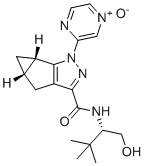
APD-371
CAS No. 1268881-20-4
APD-371( Olorinab | APD371 | APD 371 )
Catalog No. M11128 CAS No. 1268881-20-4
APD-371 (APD371, Olorinab)?is a potent, selective and orally available CB2 agonist with EC50 of 6.2 nM; displays no activity against CB1 receptors (EC50>10 uM).
Purity : >98% (HPLC)
 COA
COA
 Datasheet
Datasheet
 HNMR
HNMR
 HPLC
HPLC
 MSDS
MSDS
 Handing Instructions
Handing Instructions
| Size | Price / USD | Stock | Quantity |
| 5MG | 110 | Get Quote |


|
| 10MG | 177 | Get Quote |


|
| 25MG | 357 | Get Quote |


|
| 50MG | 530 | Get Quote |


|
| 100MG | Get Quote | Get Quote |


|
| 200MG | Get Quote | Get Quote |


|
| 500MG | Get Quote | Get Quote |


|
| 1G | Get Quote | Get Quote |


|
Biological Information
-
Product NameAPD-371
-
NoteResearch use only, not for human use.
-
Brief DescriptionAPD-371 (APD371, Olorinab)?is a potent, selective and orally available CB2 agonist with EC50 of 6.2 nM; displays no activity against CB1 receptors (EC50>10 uM).
-
DescriptionAPD-371 (APD371, Olorinab)?is a potent, selective and orally available CB2 agonist with EC50 of 6.2 nM; displays no activity against CB1 receptors (EC50>10 uM); exhibits activity in rat model of osteoarthritis pain.Pain Phase 2 Clinical.
-
In VitroA comprehensive in vitro profile of Olorinab (APD 371) (6) shows that single digit nanomolar potency and full intrinsic efficacy are maintained in all species assessed, and that Olorinab (APD 371) is highly selective for CB2 over CB1 in both binding and functional assays. Furthermore, Olorinab (APD 371) induces efficient receptor internalization (~106% relative to the CB1/2 agonist CP55,940) in CHO cells expressing HA-tagged rat CB2 suggesting that, according to the hypothesis, Olorinab (APD 371) would be able to drive agonist-induced receptor recycling.
-
In VivoOlorinab (APD 371) significantly increases paw withdrawal thresholds at doses ≥3 mg/kg PO (ED50=2.3 mg/kg). In a separate experiment, a single dose of Olorinab (APD 371) (10 mg/kg, PO) inhibits paw withdrawal threshold for up to 4 hours after administration. Seperately, the analgesic effects of Olorinab (APD 371) are shown to be highly likely mediated via activity at CB2 receptors.
-
SynonymsOlorinab | APD371 | APD 371
-
PathwayGPCR/G Protein
-
TargetCannabinoid Receptor
-
RecptorCannabinoid Receptor
-
Research AreaNeurological Disease
-
IndicationPain
Chemical Information
-
CAS Number1268881-20-4
-
Formula Weight357.414
-
Molecular FormulaC18H23N5O3
-
Purity>98% (HPLC)
-
SolubilityIn Vitro:?DMSO : 200 mg/mL (559.58 mM)
-
SMILESO=C(C1=NN(C2=C[N+]([O-])=CC=N2)C3=C1C[C@@]4([H])[C@]3([H])C4)N[C@H](CO)C(C)(C)C
-
Chemical Name3-((4aS,5aS)-3-(((S)-1-hydroxy-3,3-dimethylbutan-2-yl)carbamoyl)-4,4a,5,5a-tetrahydro-1H-cyclopropa[4,5]cyclopenta[1,2-c]pyrazol-1-yl)pyrazine 1-oxide
Shipping & Storage Information
-
Storage(-20℃)
-
ShippingWith Ice Pack
-
Stability≥ 2 years
Reference
1. Sangdon Han, et al. ACS Med. Chem. Lett., 2017, 8 (12), pp 1309-1313.
molnova catalog



related products
-
Bay 59-3074
A potent, selective cannabinoid CB1/CB2 receptor partial agonist with Ki of 48.3, and 45.5 nM for human CB1 and human CB2 receptors, respectively.
-
CB1 antagonist 2
CB1 antagonist 2 is caimabinoid 1 (CB1) antagonist extracted from patent WO2016184310A1, compound 3. Which inhibits CB1 in vivo with an IC50 of 25.5 nM.
-
Pravadoline
Pravadoline is a cannabinoid receptor agonist. Pravadoline inhibited the PGs synthesis in mouse brain and displayed antinociceptive activity in rodents subjected to a variety of thermal, chemical, and mechanical nociceptive stimuli.



 Cart
Cart
 sales@molnova.com
sales@molnova.com


